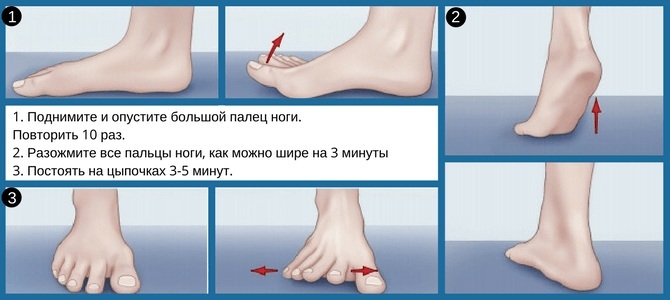The pelvic muscles provide movement to the hip joint. The iliopsoas muscle is part of the anterior group and consists of a large lumbar and iliac. Usually this group is considered as a whole.
Record content:
-
1 What is the iliac muscle
- 1.1 Functions
- 1.2 Structure
- 2 Types of diseases
- 3 Symptoms
- 4 The causes of organ diseases
- 5 Diagnostics
- 6 When to see a doctor
- 7 Prophylaxis
-
8 Treatment methods
- 8.1 Medications
- 8.2 Traditional methods
- 9 Other methods
- 10 Possible complications
- 11 Iliac video
What is the iliac muscle
The iliac muscle is located in the pelvis and, in combination with other muscles of the lower limb girdle, is responsible for the movement of the leg and body relative to each other. It is a separate integral organ of the human body, which has a certain structure, development, position and function.
Functions
The iliac muscle is located in the anterior muscle group of the lower limb girdle and has 2 heads, as well as 2 fixation points. When contracted, the muscle is shortened, 2 points of its fixation come closer together, performing the main function of the muscle, namely, movement in the joint.
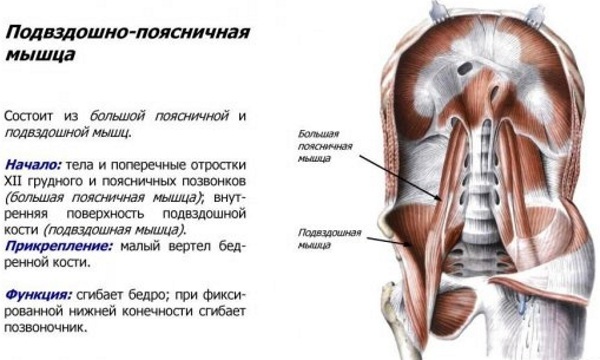
The first fixation point of the iliac muscle is located in the iliac fossa, the muscle fills the iliac fossa completely, capturing the superior and inferior anterior crests of the iliac bone.
From the iliac fossa, the fibers of the iliac muscle go downward, where they combine with the psoas major muscle into the iliopsoas muscle, pass under the inguinal ligament, in the muscle lacuna, and a single tendon are attached to the second attachment point - the lesser trochanter of the femur on its inner surface.
With a fixed pelvis, contraction of the iliac muscle produces supination of the leg, that is, turning it outward. With a fixed leg, contraction of the iliopsoas muscle flexes the lumbar spine and tilts the trunk forward.
Structure
The iliac muscle consists of an abdomen, a contracting portion, and two tendons that attach to the bones. The iliac muscle belongs to the group of skeletal striated muscles, the contraction of which a person can cause by volitional effort. The muscle consists of bundles of striated fibers, which are combined by connective tissue into bundles of a larger order.
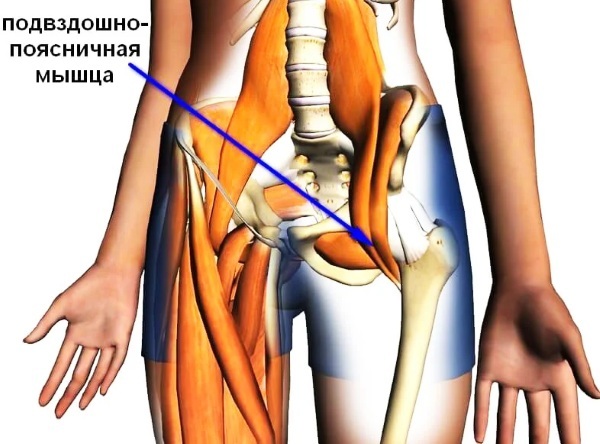
The neurovascular bundles that feed the muscle pass through the connective tissue. Outside, the muscle is covered with dense connective tissue called fascia. The femoral nerve passes between the iliac and psoas major muscles, which is important in the development of symptoms of the lesion of the iliac muscle.
Types of diseases
Muscle dysfunction, or myalgia, is manifested by moderate muscle pain, which most often goes away on its own.
There are no morphological changes in the structure of muscle tissue, blood vessels and nerves feeding the muscle. The diagnosis of functional disorders in muscle function is a "diagnosis of exclusion" and can only be made after a thorough examination after excluding other causes of pain.
Muscle lesions of an organic nature can occur as an isolated muscle disease or as a manifestation of systemic pathology. Organic lesions are more severe and require careful examination, determination of the cause and treatment.
The most common causes of organic muscle damage:
- muscle injury;
- vascular pathology;
- neurogenic myopathies;
- infectious myositis;
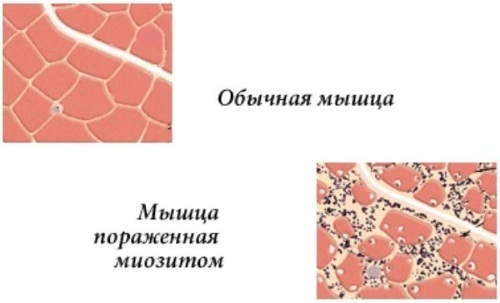
- toxic myopathy;
- as a symptom of autoimmune diseases;
- congenital metabolic diseases;
- endocrine diseases;
- electrolyte disturbances.
Congenital neuromuscular diseases:
- myodystrophies of Duchenne, Becker, Emery-Dreyfus, Landouzy-Dejerine, Erba-Roth;
- Charcot-Marie neural amyotrophy;
- spinal amyotrophies of Werdnig-Hoffmann;
- myotonia;
- myasthenia gravis.
These diseases are caused by a certain genetic mutation that is inherited. They have a characteristic clinical picture and are diagnosed in childhood or adolescence.
Symptoms
The iliac muscle in the girdle of the lower limb gives manifestations when it is affected in the area of the anterior surface of the thigh during leg movements in hip joint, as well as in the lumbar region when bending the trunk or radiate to the abdomen and groin, which makes it difficult diagnostics.
Myalgia (or muscle pain) is one of the most common manifestations of muscle disease. Pain can be acute or chronic, short or long, moderate or intense.
It is important to understand what triggers the onset of pain, causes it to intensify and what leads to its disappearance. The pain intensifies when walking, running, extending the leg, in the prone position. Palpation of the muscle is characterized by the occurrence of sharp pain. Palpation should be done just below the inguinal ligament or where the muscle attaches to the femur.
Another symptom of the defeat of the iliac muscle is the adoption of a forced position by the patient to reduce pain. In a standing position, the pelvis is skewed towards the lesion, the lower back is over-extended forward (hyperlordosis of the lumbar spine).
When walking, the patient leans forward or to the side of the lesion, and in severe cases tries to avoid running and long walking. The patient will sleep mainly on his back, the position on his stomach leads to increased pain.
Due to the passage of the femoral nerve between the iliac and psoas major muscles, neurological symptoms may occur when it is affected. The patient will complain of paresthesia ("goose bumps") on the front and inner surface of the leg, a decrease in the sensitivity of the skin of the leg, or vice versa of its increase.
There may be a decrease in muscle strength in the leg, resulting in occasional stumbling when walking.
A secondary lesion of the hip joint can complicate the diagnosis of the lesion. Incorrect joint work due to the curvature of the bone skeleton leads to the gradual development of inflammation and contractures, impaired movement in the joint, and aggravated pain syndrome. The pain manifests itself in the area of the femoral head and in the popliteal fossa.
The causes of organ diseases
Functional disorders in the work of a muscle occur due to its improper work: spasm, hyperextension, overexertion, pinching, overwork, prolonged lack of muscle movement or walking in an uncomfortable shoes.
The psoas muscle is located in the pelvis, in the girdle of the lower limb, so muscle injury can occur when injury to the pelvis or excessive leg movements in the hip joint (outward rotation, abduction, flexion).
Pain in the psoas muscle can be caused by a violation of the blood supply to the muscle due to compression of the vessel by a tumor, aneurysm, overlap of the lumen of the vessel with a thrombus, atherosclerotic plaque, narrowing of the arteries against the background of uncompensated high arterial pressure.
Pain in the psoas muscle can be caused by damage to the nerve trunks that innervate it or compression of them due to curvature of the spine.
Muscle pain can occur against the background of an infectious disease: viral (Coxsackie virus, influenza) or bacterial (brucellosis, leptospirosis) infection. The infectious agent can enter the muscle through a direct wound or through the blood. In the muscle, the formation of purulent painful abscesses is possible.
Separately, epidemic myalgia is isolated when infected with the Coxsackie virus. Muscle pain in this condition is accompanied by fever, vomiting, and diarrhea. The disease often occurs in the form of outbreaks in children's groups.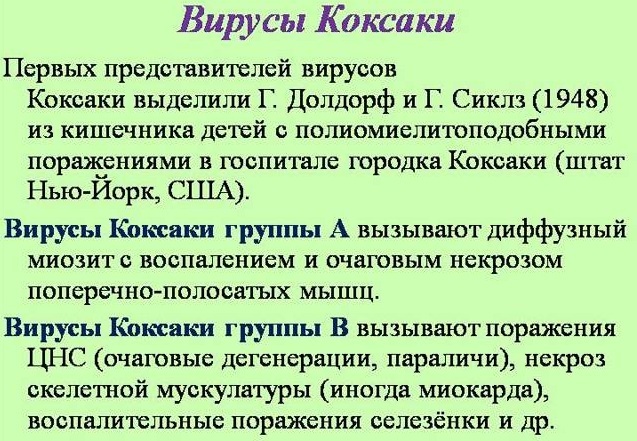
Toxic systemic muscle damage is possible when toxic substances are ingested (alcohol, botulinum toxin), overdose of any medicinal products, poisoning with toxic substances (lead, carbon monoxide).
Muscle pains have been reported as a side effect when taking cholesterol-lowering drugs (statins).
Muscle pain is a fairly common symptom of autoimmune diseases, such as polymyalgia rheumatica, Still's disease in adults, Wegener's granulomatosis, polyarteritis nodosa, systemic lupus erythematosus, myofascial syndrome, polymyositis, dermatomyositis and many others.
Autoimmune diseases are diagnosed by a rheumatologist on the basis of a detailed analysis of anamnesis, clinical picture and are confirmed using laboratory and instrumental research methods.
Diagnostics
An important place in diagnostics is occupied by laboratory and instrumental studies. You can go through all the necessary studies for free at the polyclinic at your place of residence after consulting a therapist or by contacting a private medical clinic for a fee.
- Biochemical examination of venous blood to the level of the enzyme CPK (creatine phosphokinase) - a simple and affordable diagnostic method that will allow for differential diagnosis of diseases. By the level of CPK, myalgia can be divided into two large groups: with an increased level of the enzyme and its normal value. The average price for an analysis with blood sampling is 640 rubles. Blood should be donated in the morning on an empty stomach; in a couple of days, be sure to exclude the intake of alcoholic beverages and physical activity to prevent distortion of the test results.
- Immunological tests for the determination in the blood of antinuclear antibodies, rheumatoid factor, antibodies to cyclic citrulline-containing peptide (ACCP) will facilitate the differential diagnosis of myalgias and rheumatological diseases. The average price for a set of analyzes is 1500 rubles.
- Determination of markers of inflammation: erythrocyte sedimentation rate (ESR) in a general blood test (average price of an analysis - 550 rubles), C-reactive protein in a biochemical blood test (average price - 800 rubles). An increase in the level of these indicators indicates the presence of a focus of inflammation in the body.
- Electroneuromyography will help determine the location and nature of muscle damage. During the study, the potentials arising in the muscles, at rest and excitation, are recorded using cutaneous electrodes. The average research price is 3000 rubles.
-
MRIhip joint is carried out to exclude articular pathology. Average price - 4000 rubles.
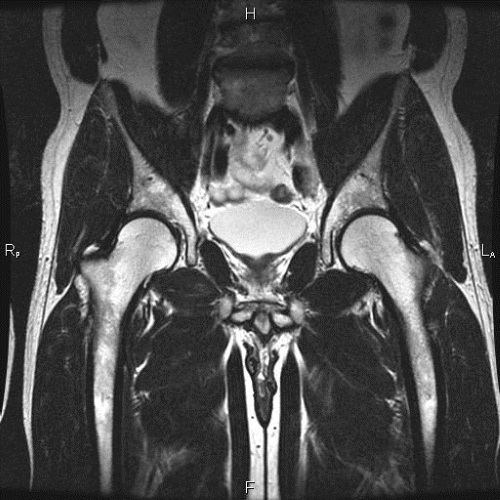
- Lumbosacral X-ray the spine is performed to exclude osteoarticular pathology of the spine. Average price - 1000 rubles.
- Determination of the level of magnesium in the venous blood. Insufficient levels of magnesium in the blood can negatively affect muscle function. The average price with blood sampling is 500 rubles.
- Venous blood lipid profile. Elevated blood lipids (cholesterol, triglycerides) may indicate atherosclerotic vascular lesions of the body. The average price of the analysis is 1200 rubles.
- Molecular genetic research are required for congenital muscle diseases to confirm the diagnosis.
When to see a doctor
You should consult a doctor at the first symptoms of the disease. Indeed, under the usual myalgia, serious systemic diseases can be hidden, requiring urgent diagnosis and treatment. You can go to a doctor's appointment without test results.
At the appointment, the doctor will take a history, clarify the nature of the pain, conduct a physical examination, additional tests and will prescribe the laboratory and instrumental diagnostic methods and consultations of narrow specialists.
If myalgia develops, it is best to make an initial appointment with a general practitioner or general practitioner. If indicated, the doctor will refer you to narrow specialists: a neurologist, rheumatologist, orthopedist, surgeon, exercise therapy doctor, geneticist, medical rehabilitation therapist or physiotherapist.
In the presence of neurological symptoms (the appearance of "goose bumps", tingling, weakness in the limb, decreased sensitivity), you should directly contact a neurologist.
In the presence of systemic joint damage, stiffness and pain in the joints in the morning, skin manifestations (rashes, nodules, redness), the spread of pain to other muscle groups, refer to rheumatologist.
If pain is associated with a lesion of the hip joint, make an appointment with an orthopedist for additional diagnosis and treatment of the joint. When all systemic diseases are excluded and the functional nature of the pains is determined, it will not be superfluous to get consultation of an exercise therapy doctor or a rehabilitation therapist and, if necessary, take courses of massage, physiotherapy exercises or physiotherapy.
Prophylaxis
Prevention of functional disorders of the iliac muscle includes proper nutrition, regular moderate physical activity (for example, swimming in the pool, Nordic walking), avoiding excessive training, selection orthopedic shoes.
For the prevention of systemic diseases accompanied by myalgia, you should undergo an annual medical examination for timely diagnosis. If any new symptoms occur, you should immediately consult a doctor to find the cause of the pain and prescribe therapy.
Treatment methods
There are a lot of methods of the disease, however, the largest share is occupied by drug methods.
Medications
-
Pain medications
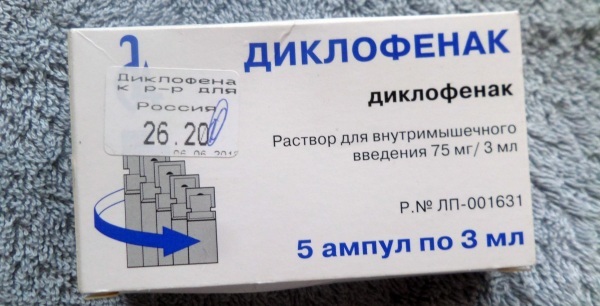
Diclofenac injections.
To relieve pain, non-steroidal anti-inflammatory drugs are used in the form of tablets, ointments, gels, rectal suppositories, intramuscular injections. Drugs of a number of NSAIDs have side effects (allergic reactions, toxic effects on gastrointestinal tract, blood thinning), so it is worth using them only when necessary and not abuse them.
Choose the minimum effective dosage and take it in the minimum course. To reduce toxic effects on the stomach, take the drug at the end of a meal with water. Use the drugs in dosages according to the instructions.
The iliac muscle is located in the pelvis, therefore, to relieve pain, it is better to use systemic drugs in the form of tablets, rectal suppositories or intramuscular injections.
The most popular pain relievers are: Nimesulide, Diclofenac, Ibuprofen, Ketanov.
- Vitamins and macronutrients
Magnesium is necessary for the body to work muscles, conduct a nerve impulse. Magnesium levels are deficient. To restore the level of magnesium, it is recommended to drink a course of magnesium preparations in an easily accessible form for the body.
| Trade name of the drug | Dosage | Duration of the course |
| Magnerot | 1 tablet of 500 mg 3 times a day. | 3 weeks or until blood magnesium levels return to normal. |
| Magne B6 | 1 tablet 4-6 times a day. |
Traditional methods
Alternative methods are effective only for relieving symptoms and alleviating the general condition of the affected area. It is not recommended to use them as a systemic treatment.
The main household remedies are:
- When stretching, muscle spasm, you can take a hot bath with sea salt to relax. A special effect will be after taking a bath with the addition of epsom salt (magnesium sulfate).

- A cold compress should be applied to the site of the injury. Cold constricts blood vessels, thereby reducing inflammation at the site of injury and relieving pain.
- Massaging the sore area with oil with a few drops of peppermint essential oil or half a teaspoon of red pepper powder will help relieve pain.
- Rubbing the affected area with apple cider vinegar and water is an ancient proven way to relieve pain.
Other methods
- To restore the damaged muscle, it is necessary to create peace for it: exclude physical activity, spend more time in a sitting and lying position. With the disappearance of acute pain, you can begin to gradually develop the damaged muscle, conducting light gymnastics.
- Acupuncture is known as the oldest Chinese method for relieving muscle pain. Impact on trigger points with needles leads to reflex muscle relaxation and pain relief. Acupuncture sessions are conducted in courses.
- The self-massage course is the easiest and most affordable pain relief method. The best massage you can do yourself, relying on your feelings.
Possible complications
Ignoring the symptoms of the disease by the patient always has its consequences, unfortunately, often irreversible. The most common consequences of diseases of the iliac muscle in the absence of treatment are curvature of the spine, a violation work of the hip joint, violation of gait and freedom of movement, the appearance of severe persistent pain in the back or leg.
The iliopsoas muscle is located in the pelvis, next to the internal organs, and symptoms of its damage should not be overlooked. Muscle pain is often a symptom of serious systemic autoimmune, inflammatory, infectious diseases that require urgent treatment. Delay in diagnosis can reduce a person's quality of life and even lead to fatal consequences.
Iliac video
Relaxation of the iliopsoas muscle:

